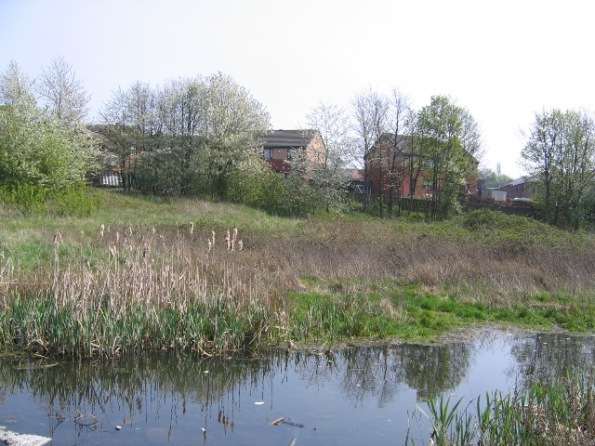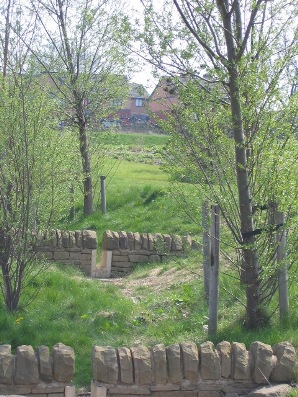Where
Location
The Manor Estate, Sheffield, South Yorkshire, UK
Description
A new (regenerated) housing estate. The SuDS scheme is located on adjacent council owned public open space.
The main existing surface water sewer near to the site was found to be inaccessible through a shallow sewer network within the new housing. Alternative solutions were presented including the installation of a permanent pump to transfer water upwards to the main sewer and the tunnelling of a new connecting sewer 15 metres below the surface. Both were deemed too expensive. The opportunity of using the adjacent developing park, with its watercourse, to store and treat water seemed more appropriate and an opportunity to display better practice. The park development team within the Council were keen to have control over the process of design as the site was being developed as a park.
SuDS used
A series of ponds and basins to attenuate and treat road runoff from a new housing estate on brownfield land.
|
|
|
Figure 1 Ponds which help to control the management of water through the site |
How it works
Flows were modelled based on impermeable area measurement from within a block of 300 houses and their service roads that naturally drained towards the park site. No attenuation or treatment occurred within the housing area so the park is receiving a ‘raw’ product in variable flows. All drainage enters the Park at one point and is then managed through a series of basins dropping down the contours of the site.
|
|
|
Figure 2 Swales that run through the site with inlet/outlet structures |
The top basin acts as the main management tool for silt collection and pollution interception. Below each of the top two basins there are sand filters installed behind stone walling with absent jointing on vertical faces in the lower courses to allow water movement. These filters manage flow at a rate determined by the resistance of the filter and the exit pipework cross-sectional area. This low flow passes down to the next basin below through a shallow low flow channel. If either of the upper two basins are unable to contain and release water through their filters overflow occurs through an alternative grassed channel route down to the next basin. The third basin has a volume release control out to an existing dry valley which leads to the water course. If the third basin is unable to handle flow this overflows onto a grass arena as shallow flow and exits through a further control device down to the dry valley.
Specific details
There are plans to possibly link the ponds to a downstream watercourse, dammed into a lake for coarse fishing in part to encourage community ownership of the ponds.
Amenity / biodiversity
An extensive public engagement programme was mounted as part of University of Sheffield’s work in the EPSRC WanD project. This especially targeted excluded youngsters and the ponds were used as a re-engagement process, including the amenity and biodiversity value that was highly successful at least over the 2 years of the study.
Water quality management
This site is being developed as an inner city park and therefore releasing water into the park after a management train in a high quality state was seen as a basic requirement. Future plans for the Park include a fishing lake, which will more than likely be supplemented by this run-off source, therefore quality is particularly important.
Source Control measures that normally characterise sustainable drainage were not feasible on this project due to a pre-existing layout. Therefore this SuDS design should be considered a retrofit solution rather than a new SuDS exemplar.
The natural assets of the park including grasslands, heathland and wetlands have informed the design themes for the park and indeed have largely been retained but presented in a more managed framework. Water has therefore already played a role in the site in the form of a stream and recently opened up ponds. The need for drainage of the Park in order to provide better access and recreation opportunities has been carried out with the proviso that water should remain visible and not hidden in French drains for example. Water was therefore seen as an asset in creating character in the site.
Design & construction
The scheme needed to manage storm periods up to a 1 in 30 year storm with an aspiration to meet the 1 in 100 year return period storage if possible. This water was to be then released into the watercourse within the Park at greenfield rate run-off.
Turfing was used to vegetate vulnerable areas of the system such as overflow channels and the wet benches of the basins so that the system could be operational at an early date. The system was under a year’s establishment post practical completion after which it was handed over to the Council. The upper basin was managed throughout the housing development period (2 years) by the developer as it was envisaged that this would receive considerable silt load.
|
|
|
Figure 3 Turfing used to vegetate vulnerable areas of the system (Roger Nowell) |
Benefits & achievements
The scheme illustrates how an alternative approach can be taken to great advantage. As a summary the Park project has been able at no cost to:
-
Reclaim 2 hectares of land to improved landscape
-
Construct an events arena / recreational space in the form of a storm basin on difficult topography
-
Enhance the wetland ecosystem of the site
-
Bring extra management finance into a Park
-
Provide an engagement/educational opportunity for all the community which could promote ownership
The benefits to all stakeholders show that SuDS can offer opportunities not usually associated with stormwater management including finance to public projects, environmental enhancement, community rehabilitation and visual interest. Introducing SuDS to public open space reinstates lost wetlands and drainage pathways.
The challenges highlighted through the project included:
-
In the early stages of construction and in the initial operation the site experienced problems with crime including vandalism, dumping and burning out of cars.
-
Start-up problems led to poor initial water quality performance. In addition, poor ground caused a ‘swallow-hole’ to open up in the 1st pond that was not repaired for about one year.
Challenges & lessons learned
The potential (commuted sum) mechanisms for capital funding of SuDS within Public Open Space and maintenance revenue streams offer inspiration to other Local Authorities.
Details of maintenance schedules/manuals, management agreements and agreed commuted sums
As the site is to be a district park it always seemed appropriate that the Parks team of the Council took on its management. However, this was with the condition that sufficient resources were found for the work. A number of alternative ideas were explored which included:
-
Ground rents
One of the key partners in regeneration in the area is Manor and Castle Development Trust. Through negotiation they have acquired the freehold on all private housing which allows them to levy a charge on residents. This money is earmarked for land management including the District Park. Although this charge could be increased to cover the SUDS scheme there has been great concern over reliability in acquiring the charge.
-
Management Charge for the scheme
This would in effect present an additional cost over the standard water bill and therefore would not be acceptable.
-
Trust ownership of the pipe network
In order to avoid the surface water drainage proportion of the water bill going to Yorkshire Water it was suggested that the Manor and Castle Development Trust own the pipe network allowing them to directly bill residents. This was ruled out as it placed a relatively small organisation in a vulnerable position with responsibility for underground services. The Highways section of the Council were also nervous of draining into a private sewer.
-
Commuted sum (the chosen route)
The value of the overall scheme both capital and revenue had to be seen to be much better value than the conventional system. As the conventional system was extremely expensive this gave the Park project a strong position to argue for a suitable commuted sum. In addition as the Park was yet to be developed no existing management costs were available therefore it was not a case of supplementing an existing budget. An agreed figure of £250,000 allows for 25 years of management.
The Park project seeks to gain maximum regeneration benefit from all its processes. Delivery of the capital works, although managed by Bellway Homes, included a nominated local landscape social enterprise, the Green Estate company. It is envisaged that the actual delivery of management will be through this company as contractor to the Council. This means local employment and ownership and the spreading of an understanding of the scheme.






